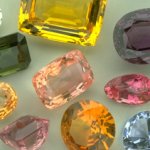Nous offrons des facilités de paiement pour le bijou de vos rêves. Demandez nous les détails. Expédition assuré gratuite !

Antique jewelry glossary
Welcome to our extensive antique jewelry glossary with around 1,500 jewelry related entries.If you feel you are missing an explanation, feel free to let us know and we will add it.
A - B - C - D - E - F - G - H - I - J - K - L - M - N - O - P - Q - R - S - T - U - V - W - X - Y - Z all
Corundum

See our:
blue corundum jewelry (sapphire) or
red corundum jewelry (ruby).
A mineral (aluminium oxide) that is the hardest mineral other than the diamond; its hardness on the Mohs scale is 9.
It is found in two varieties:
- common corundum, which is impure, coarse, opaque and granular (known as emery), and used as an abrasive
- transparent corundum, which includes the ruby and the sapphire (both identical except as to color)
Corundum (seldom colorless) exhibits a wide range of colors (blue, pink, green, yellow, etc.) and such stones are properly termed sapphires preceded by the appropriate color (designations using the names of other similar-appearing stones preceded by the word 'Oriental' being misnomers), except that the red variety is called 'ruby'. The colors in some cases are probably due to traces of metallic oxides.
The cut specimens are characterized by their vitreous luster high specific gravity, weak color dispersion, double refraction and, when colored, dichroism, which enable them to be distinguished from other varieties of stones of similar appearance, as does microscopic examination.
Some specimens show a sheen (silk) and some have an interior series of minute, needle-like inclusions (feathers) of rutile; these, when properly cut en cabochon, are star rubies and star sapphires or, when having only one ray of light, 'corundum cat's-eye'. Multicolored stones are common, and patches of two colors are sometimes found in a stone and show an apparent blended tint.
Corundum stones are cut as table cut, step cut, brilliant cut, and mixed cut.
From: An Illustrated Dictionary of Jewelry, autor: Harold Newman, publishers: Thames and Hudson









